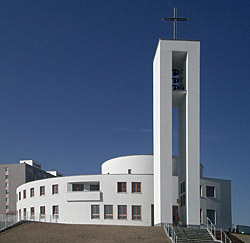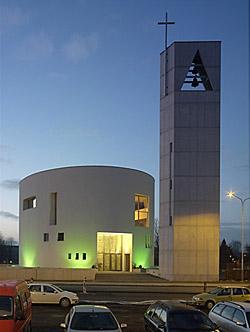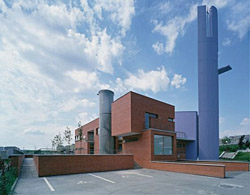
R. Biegel: Churches barely have an architectural role anymore
 |
| Mother Teresa Community Center in Prague |
There are enough places for new churches in the growing neighborhoods on the outskirts of Prague. However, in their design, the church is not considered - there is no demand for it. "It seems that the church no longer belongs in the basic 'equipment' of the city in the eyes of many, which I believe is a big mistake," says art historian and managing director of the Old Prague Club Richard Biegel.
For example, this week marks the 120th anniversary of the laying of the foundation stone of the Neo-Gothic Church of St. Ludmila in Královské Vinohrady, Prague. In newly constructed or expanded neighborhoods, churches were still built in the 20th century. Between the wars, Plečnik's Church of the Sacred Heart of Jesus in Vinohrady, Gočár's Church of St. Wenceslas in Vršovice, or Janák's Hussite Church in Vinohrady were constructed. One of the few examples from today is the Mother Teresa Community Center in Jižní Město.
 |
| Roman Catholic Church of the Holy Spirit in Ostrava |
Because sacred buildings are built so infrequently today, they seem to have a hard time finding their expression. Contemporary churches that have arisen in Slovakia or Poland, according to historians, often feature an almost forced monumentality associated with grand postmodern shapes, which dominate the surroundings but generally leave the impression of a somewhat unsuccessful gesture or even kitsch.
More new churches are being built in Moravia than in Bohemia, but there too, the characteristics applied to both mentioned countries often hold true. However, there are examples of new sacred architecture where the authors approached the place and the theme with humility. "Much more successfully, I find the thoughtful small-scale buildings like the Chapel of Our Lady Queen in Jestřebí by architects Kuba and Pilař, which, through their modesty combined with the purity and persuasiveness of the architecture, can create a timeless identity and appeal to non-Catholic audiences as well," Biegel noted.
He believes that the theme of sacred buildings will one day return to mainstream production. "When that happens, we will immediately know better what kind of building to construct and how to naturally integrate it into the urban environment," he stated.
 |
| St. Procopius Community Center in Prague |
In contrast, many experts and laypeople perceive the nearby Church of St. Michael as an exceptionally negative way of handling a monument in the very heart of the historic city. After years of searching for its new purpose, a shopping center will likely be established in the church.
If discussions among experts and public protests did not help revive this church, the idea of the Catholic Church to sell the Church of St. Cajetan in Nerudova Street did. Church representatives argued eight years ago that the city center is depopulating and pastoral work needs to be directed to the outskirts of Prague - all this according to the church in a situation where the property settlement between the state and the churches has not been resolved and there is a lack of money for the maintenance of monuments. Public protests from both experts and laypeople ultimately prevented the sale of the church.
According to Biegel, the situation in the countryside is far worse, especially in Western Bohemia, where hundreds of extraordinarily valuable buildings stand for which the church has no money for maintenance and to which almost no one goes. "The state should, in the context of preserving cultural memory, strive for their rescue, as their disappearance or transformation into a commercial object would mean the loss of the natural and still respected spiritual center for hundreds of villages," believes the historian.
The English translation is powered by AI tool. Switch to Czech to view the original text source.
1 comment
add comment
Subject
Author
Date
Není to jen o kostelech, ale o celé společnosti
Thomas
27.11.08 10:01
show all comments





